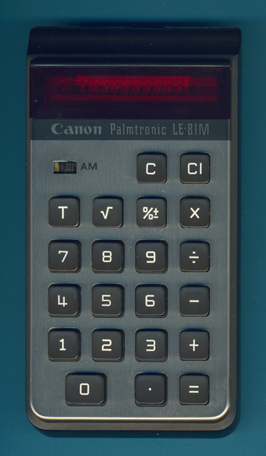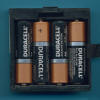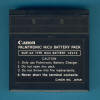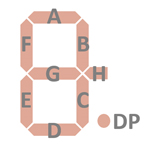
DATAMATH CALCULATOR MUSEUM
 |
DATAMATH CALCULATOR MUSEUM |
Canon LE-81M
| Date of introduction: | 1974 | Display technology: | LED-stick |
| New price: | $79.95 | Display size: | 8 |
| Size: | 5.5" x 3.1" x 1.5" 139 x 78 x 37 mm3 |
||
| Weight: | 6.7 ounces, 190 grams | Serial No: | 503268 |
| Batteries: | 4*NiCd AA or 4*AA Alkaline | Date of manufacture: | mth 06 year 1974 |
| AC-Adapter: | Origin of manufacture: | Japan | |
| Precision: | 8 | Integrated circuits: | TMC0605 |
| Memories: | Displays: | Bowmar Optostic R7H-122-9 | |
| Program steps: | Courtesy of: | Peter Muckermann († April 21, 2021) |

![]()
 The
LE-81M seems to be the direct successor of the odd looking LE-81
calculator. It was introduced together with the LE-100
sporting 10-digits and the scientific calculator F-5. The
LE-81M supports with a small sliding switch an "Adding Machine" mode using an
independent add register that can be read out with a single press of the [T] key
and cleared with a second consecutive press of the [T] key.
The
LE-81M seems to be the direct successor of the odd looking LE-81
calculator. It was introduced together with the LE-100
sporting 10-digits and the scientific calculator F-5. The
LE-81M supports with a small sliding switch an "Adding Machine" mode using an
independent add register that can be read out with a single press of the [T] key
and cleared with a second consecutive press of the [T] key.


 Dismantling the featured Canon LE-81M manufactured in June
1974 by Canon in Japan reveals a rather compact design with three printed
circuit boards (PCBs) for main electronics, display, and keyboard powered by
either a battery pack with four AA-sized rechargeable NiCd cells or a battery
holder for four disposable Alkaline batteries. The Main-PCB is centered around a
Texas Instruments single-chip calculator circuit and supported by a
myriad of discrete components:
Dismantling the featured Canon LE-81M manufactured in June
1974 by Canon in Japan reveals a rather compact design with three printed
circuit boards (PCBs) for main electronics, display, and keyboard powered by
either a battery pack with four AA-sized rechargeable NiCd cells or a battery
holder for four disposable Alkaline batteries. The Main-PCB is centered around a
Texas Instruments single-chip calculator circuit and supported by a
myriad of discrete components:
|
• Calculating Unit - TMC0605 single-chip calculator circuit • Display Driver - No Segment Drivers and discrete Digit Drivers • Clock signal generation for TMC0605 with discrete components • Power converter with discrete components and transformer • 17-pin connector to the Display-PCB • 20-pin connector to the Keyboard-PCB |
![]() Calculating Unit: The
LE-81M makes use of the TMC0605 single-chip calculator circuit derived from the TMS1802,
better known as first "calculator-on-a-chip" but with a Read-Only program Memory
increased from 320 Words to 384 Words x 11 Bits. The first design of the
TMS0600 architecture could be found with
the TI-2550 introduced already in January 1974 and centered around the TMS0601
chip.
Calculating Unit: The
LE-81M makes use of the TMC0605 single-chip calculator circuit derived from the TMS1802,
better known as first "calculator-on-a-chip" but with a Read-Only program Memory
increased from 320 Words to 384 Words x 11 Bits. The first design of the
TMS0600 architecture could be found with
the TI-2550 introduced already in January 1974 and centered around the TMS0601
chip.
![]() Display: Texas Instruments introduced together with the
TMS0100 calculator chip two pre-configured
LED (Light-Emitting-Diode) modules (DIS40,
DIS95) based on the
TIL360 arrays and the corresponding segment drivers (SN75491) and digit drivers (SN75492). Most early 8-digit designs
like the LE-80 made use of these parts
exhibiting two disadvantages:
Display: Texas Instruments introduced together with the
TMS0100 calculator chip two pre-configured
LED (Light-Emitting-Diode) modules (DIS40,
DIS95) based on the
TIL360 arrays and the corresponding segment drivers (SN75491) and digit drivers (SN75492). Most early 8-digit designs
like the LE-80 made use of these parts
exhibiting two disadvantages:
|
• SN75491, SN75492 - Limited to designs with 5 or 6 batteries • TIL360 - Cost driver number one in the calculator design |
![]() Texas Instruments consequently introduced with the SN75493 and SN75494
revised display drivers optimized for designs with 3 or 4 batteries but the true
innovation could be observed with the technology how to manufacture the 9-digit
LED displays used with early four-function calculators:
Texas Instruments consequently introduced with the SN75493 and SN75494
revised display drivers optimized for designs with 3 or 4 batteries but the true
innovation could be observed with the technology how to manufacture the 9-digit
LED displays used with early four-function calculators:
|
• 1972: Two Hermetic Multi-Digit Calculator Numeric Seven-Segment LED Displays soldered onto
a PCB • 1973: Nine Seven-Segment LED Displays soldered onto a PCB • 1974: Nine Seven-Segment LED Display Chips bonded onto a PCB • 1975: Nine small Seven-Segment LED Display Chips bonded onto a PCB with additional magnifying lens • 1976: LED Displays near extinguished by VFD and LCD technology |
The featured LE-81M manufactured in June 1974 makes use of a Bowmar Optostic R7H-122-9 Nine-Digit display module using Chip-on-Board (COB) technology with each character formed by bonding seven individual Segment chips and one Comma chip bonded directly to a PCB and protected with a red plastic lens. The display module is connected with a long 17-pin flat-cable to the Main-PCB.
Display Driver: The Main-PCB of the featured LE-81M manufactured in June 1974 makes use of nine Transistors with supporting Resistors as discrete Digit Drivers for the LED display while the TMC0605 chip drives the Segments directly.
Clock: While the nominal clock frequency of the TMS0600 single-chip calculator circuit is specified with 250 kHz, uses the LE-81M a slower pace to reduce overall power consumption of the product slightly. The astable multivibrator using two discrete transistors operates at a frequency between 150 kHz and 250 kHz, we observed with the featured LE-81M manufactured in June 1974 a clock frequency of 180 kHz.

 Power Supply: The LE-81M is powered by either a sealed
battery pack with four AA-sized
rechargeable NiCd cells or a battery holder for four disposable Alkaline batteries resulting in a typical voltage between
4.0 V
(completely depleted cells) and 6.0 V (new cells). The
Main-PCB hosts a power converter circuit centered around an astable
multivibrator, step-up transformer and various diodes and capacitors to generate
the supply voltages for the TMC0605 chip and the clock oscillator. We observed
in the featured LE-81M manufactured in June 1974 output voltages of
VDD =
-7.9 V and VGG = -15.2 V for the electronics and measured the current consumption with:
Power Supply: The LE-81M is powered by either a sealed
battery pack with four AA-sized
rechargeable NiCd cells or a battery holder for four disposable Alkaline batteries resulting in a typical voltage between
4.0 V
(completely depleted cells) and 6.0 V (new cells). The
Main-PCB hosts a power converter circuit centered around an astable
multivibrator, step-up transformer and various diodes and capacitors to generate
the supply voltages for the TMC0605 chip and the clock oscillator. We observed
in the featured LE-81M manufactured in June 1974 output voltages of
VDD =
-7.9 V and VGG = -15.2 V for the electronics and measured the current consumption with:
| Mode | Display | Current VBAT = 6.0 V |
Clock Frequency |
| Calculating | 0. | 55 mA | 180 kHz |
| Calculating | 88888888. | 131 mA | 180 kHz |
The battery packs are compatible with the three first generations of Canon's product portfolio of Portable Handheld Calculators with LED display but don't fit the LE-81:
|
• 1st Generation:
LE-10 • 2nd Generation: LE-80, LE-80M, LE-80R, LE-82 • 3rd Generation: LE-81M, LE-100, F-5, FC-80 |
Keyboard: The keyboard of the LE-81M uses spring-supported plastic keys pushing a small conductive rubber element against two contacts etched on a single-sided phenolic PCB combining both long-travel keys with reasonable manufacturing costs while maintaining longevity of the calculator. The keyboard module is connected with a short 20-pin flat-cable to the Main-PCB.
Canon introduced in 1974 their more cost optimized and last generation of calculators with LED displays:
| • 4th Generation: LE-83, LE-84 and LE-85 |
The next product in Canon's portfolio of Portable Handheld Calculators was the LD-80 sporting a green VFD (Vacuum-Fluorescent-Display) and introduced in 1974, too.

 Update (December 2024):
On our quest to complete the
Characterization of Single-Chip Calculator Circuits
of the TMS0600 Product Family, we decided here at
the Datamath Calculator Museum to give the Canon LE-81M calculator with its
TMC0605 chip a "Teardown Treatment" and share our findings accordingly. Disassembling the donor calculator with serial number #513006 and
manufactured in June 1974, resulted in a big surprise:
Update (December 2024):
On our quest to complete the
Characterization of Single-Chip Calculator Circuits
of the TMS0600 Product Family, we decided here at
the Datamath Calculator Museum to give the Canon LE-81M calculator with its
TMC0605 chip a "Teardown Treatment" and share our findings accordingly. Disassembling the donor calculator with serial number #513006 and
manufactured in June 1974, resulted in a big surprise:
| • The unused H-Segment outputs a lot of internal information like calculator overflow or memory register usage |
Flag-Information Output: While reverse-engineering the electrical connections of the Memory Indicator LED of the Brother Model 827R (Version 2) calculator to its TMS0603 chip, we noticed that it is wired between the H-Segment of the TMS0603 and the common cathode of Digit 8 of the LED display.
 The H-Segment Output of the TMS0600 device is a relict inherited from the
TMS0100 Product Family to render the "Fancy Four" used with some early
Vacuum Fluorescent Displays but not available with 7-Segment LED Displays like
the one used with the Canon LE-81M calculator. With the DCM-50A Platform using eleven H-Segment LEDs and most of them
turning on and off at seemingly random times while operating the TMC0605 chip, we started to analyze each of the
eleven signals during different sample calculations. To our surprise could we
decipher the "Flag-Information" encoded in ten of the 11 Digit Times:
The H-Segment Output of the TMS0600 device is a relict inherited from the
TMS0100 Product Family to render the "Fancy Four" used with some early
Vacuum Fluorescent Displays but not available with 7-Segment LED Displays like
the one used with the Canon LE-81M calculator. With the DCM-50A Platform using eleven H-Segment LEDs and most of them
turning on and off at seemingly random times while operating the TMC0605 chip, we started to analyze each of the
eleven signals during different sample calculations. To our surprise could we
decipher the "Flag-Information" encoded in ten of the 11 Digit Times:
| • D1: Not used • D2 - D4: Operation with D4 + D2 = M, D4 + D3 + D2 = D, D2 = A and S • D5: Not used • D6: Not used • D7: Memory Overflow Indicator • D8: Memory Indicator • D9: Not used • D10: Calculating Overflow Indicator • D11: Sign |
Analyzing the Feature Sets and Calculator Logic Implementations of the six known members of the (not so successful) TMS0600 Product Family, we can summarize: Too Little, Too Late. When Texas Instruments introduced the TMS0600 early in 1974, with custom-specific designs not available before Summer 1974, the market of pocket calculators diverted into two directions:
| • Enhanced Feature Set, Low Cost • Standard Feature Set, Lowest Cost |
With the rather limited program memory (384 Words * 11 Bits) and small data memory (3 * 13 Digits Registers), the functionality of all six known TMS0600 designs wasn't competitive and the restriction to LED displays with external digit drivers and missing an internal clock oscillator didn't help with the manufacturing costs of an electronic calculator.
If you have additions to the above article please email: joerg@datamath.org.
© Joerg Woerner, December 5, 2001. No reprints without written permission.